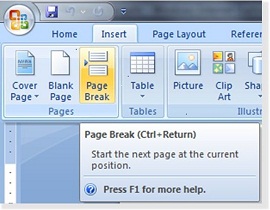
On the other hand, it’s easy to delete the extra pages. If you know you’re going to divide the document into sections, insert section breaks instead of page breaks. This is one time when planning comes in handy. 3: Check for extra pagesīefore Figure C Figure C Print Preview shows a new blank and unnecessary page between the table of contents and the first page of chapter 1. In Word 20, click the Page Layout tab | Breaks in the Page Setup group | Next Page.įigure A You can treat each of these elements as a section.

The results will be specific to each document. 1: Determine page numbering needs for each sectionīefore you can number anything, you have to discern what each section comprises.
#How to insert page break in word 2010 pdf
Note: This article is also available as a PDF download. SEE: Download: Build your Excel skills with these 10 power tips (TechRepublic)įortunately, adding sections actually makes complex page numbering schemes easier, not more difficult. This autonomy lends flexibility, but it can lead to questions about numbering pages - where do you start numbering, does each section start over with page 1, and so on. They’re all part of the same dwelling, but each room has its own purpose and décor. Susan Harkins demystifies this Word feature.Īccording to Microsoft, a section is “a portion of a document in which you set certain page formatting options.” It might help to think of sections as rooms in a house.


If you've ever been outfoxed by Word's page numbering options in a multiple-section document, here's good news: Controlling how the pages in each section are numbered is actually pretty easy. 10 steps to setting up page numbering in Word sections


 0 kommentar(er)
0 kommentar(er)
